2012 BMW 535I GRAN TURISMO tire pressure
[x] Cancel search: tire pressurePage 164 of 321
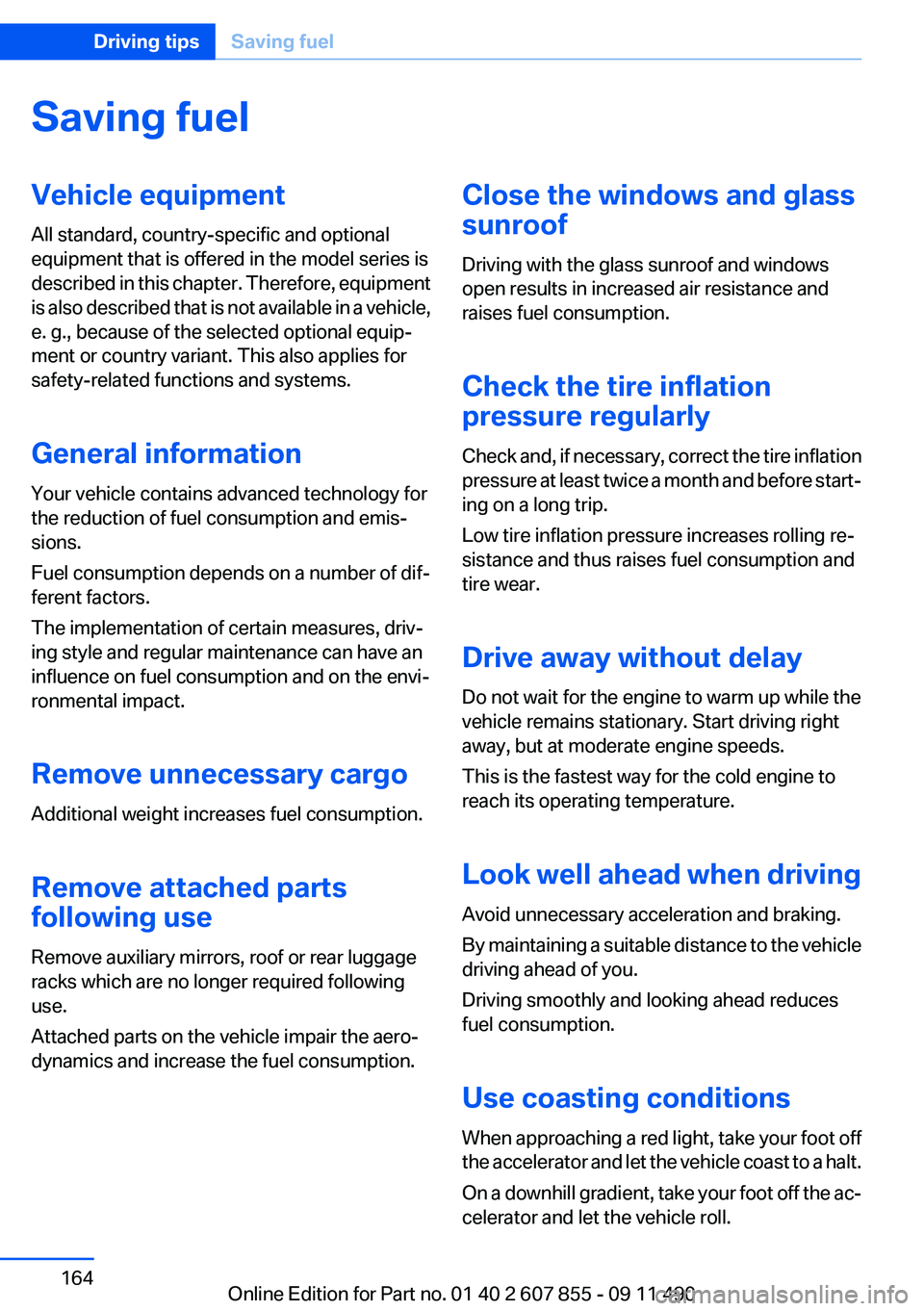
Saving fuelVehicle equipment
All standard, country-specific and optional
equipment that is offered in the model series is
described in this chapter. Therefore, equipment
is also described that is not available in a vehicle,
e. g., because of the selected optional equip‐
ment or country variant. This also applies for
safety-related functions and systems.
General information
Your vehicle contains advanced technology for
the reduction of fuel consumption and emis‐
sions.
Fuel consumption depends on a number of dif‐
ferent factors.
The implementation of certain measures, driv‐
ing style and regular maintenance can have an
influence on fuel consumption and on the envi‐
ronmental impact.
Remove unnecessary cargo
Additional weight increases fuel consumption.
Remove attached parts
following use
Remove auxiliary mirrors, roof or rear luggage
racks which are no longer required following
use.
Attached parts on the vehicle impair the aero‐
dynamics and increase the fuel consumption.Close the windows and glass
sunroof
Driving with the glass sunroof and windows
open results in increased air resistance and
raises fuel consumption.
Check the tire inflation
pressure regularly
Check and, if necessary, correct the tire inflation
pressure at least twice a month and before start‐
ing on a long trip.
Low tire inflation pressure increases rolling re‐
sistance and thus raises fuel consumption and
tire wear.
Drive away without delay
Do not wait for the engine to warm up while the
vehicle remains stationary. Start driving right
away, but at moderate engine speeds.
This is the fastest way for the cold engine to
reach its operating temperature.
Look well ahead when driving
Avoid unnecessary acceleration and braking.
By maintaining a suitable distance to the vehicle
driving ahead of you.
Driving smoothly and looking ahead reduces
fuel consumption.
Use coasting conditions
When approaching a red light, take your foot off
the accelerator and let the vehicle coast to a halt.
On a downhill gradient, take your foot off the ac‐
celerator and let the vehicle roll.Seite 164Driving tipsSaving fuel164
Online Edition for Part no. 01 40 2 607 855 - 09 11 490
Page 261 of 321
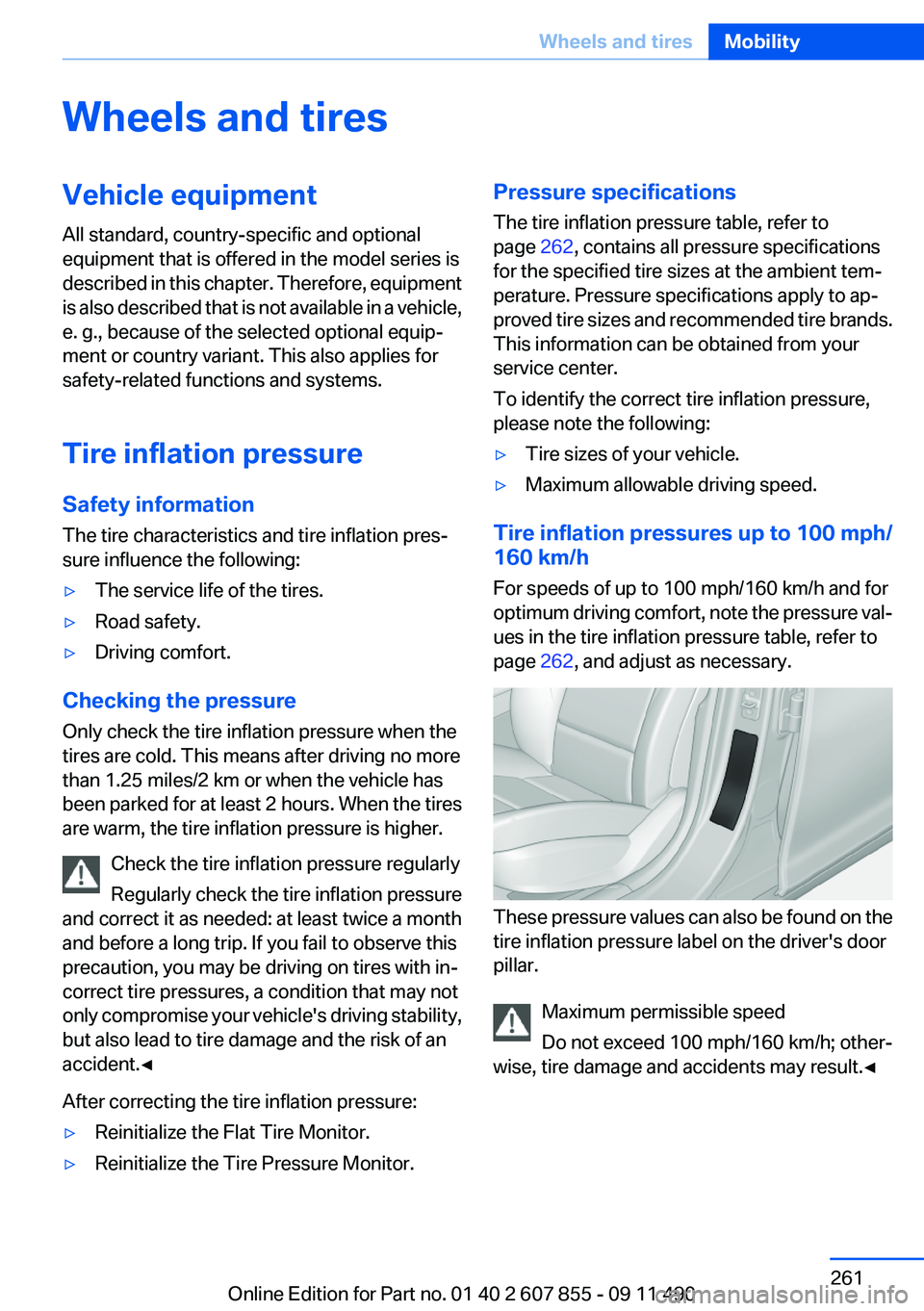
Wheels and tiresVehicle equipment
All standard, country-specific and optional
equipment that is offered in the model series is
described in this chapter. Therefore, equipment
is also described that is not available in a vehicle,
e. g., because of the selected optional equip‐
ment or country variant. This also applies for
safety-related functions and systems.
Tire inflation pressure
Safety information
The tire characteristics and tire inflation pres‐
sure influence the following:▷The service life of the tires.▷Road safety.▷Driving comfort.
Checking the pressure
Only check the tire inflation pressure when the
tires are cold. This means after driving no more
than 1.25 miles/2 km or when the vehicle has
been parked for at least 2 hours. When the tires
are warm, the tire inflation pressure is higher.
Check the tire inflation pressure regularly
Regularly check the tire inflation pressure
and correct it as needed: at least twice a month
and before a long trip. If you fail to observe this
precaution, you may be driving on tires with in‐
correct tire pressures, a condition that may not
only compromise your vehicle's driving stability,
but also lead to tire damage and the risk of an
accident.◀
After correcting the tire inflation pressure:
▷Reinitialize the Flat Tire Monitor.▷Reinitialize the Tire Pressure Monitor.Pressure specifications
The tire inflation pressure table, refer to
page 262, contains all pressure specifications
for the specified tire sizes at the ambient tem‐
perature. Pressure specifications apply to ap‐
proved tire sizes and recommended tire brands.
This information can be obtained from your
service center.
To identify the correct tire inflation pressure,
please note the following:▷Tire sizes of your vehicle.▷Maximum allowable driving speed.
Tire inflation pressures up to 100 mph/
160 km/h
For speeds of up to 100 mph/160 km/h and for
optimum driving comfort, note the pressure val‐
ues in the tire inflation pressure table, refer to
page 262, and adjust as necessary.
These pressure values can also be found on the
tire inflation pressure label on the driver's door
pillar.
Maximum permissible speed
Do not exceed 100 mph/160 km/h; other‐
wise, tire damage and accidents may result.◀
Seite 261Wheels and tiresMobility261
Online Edition for Part no. 01 40 2 607 855 - 09 11 490
Page 262 of 321
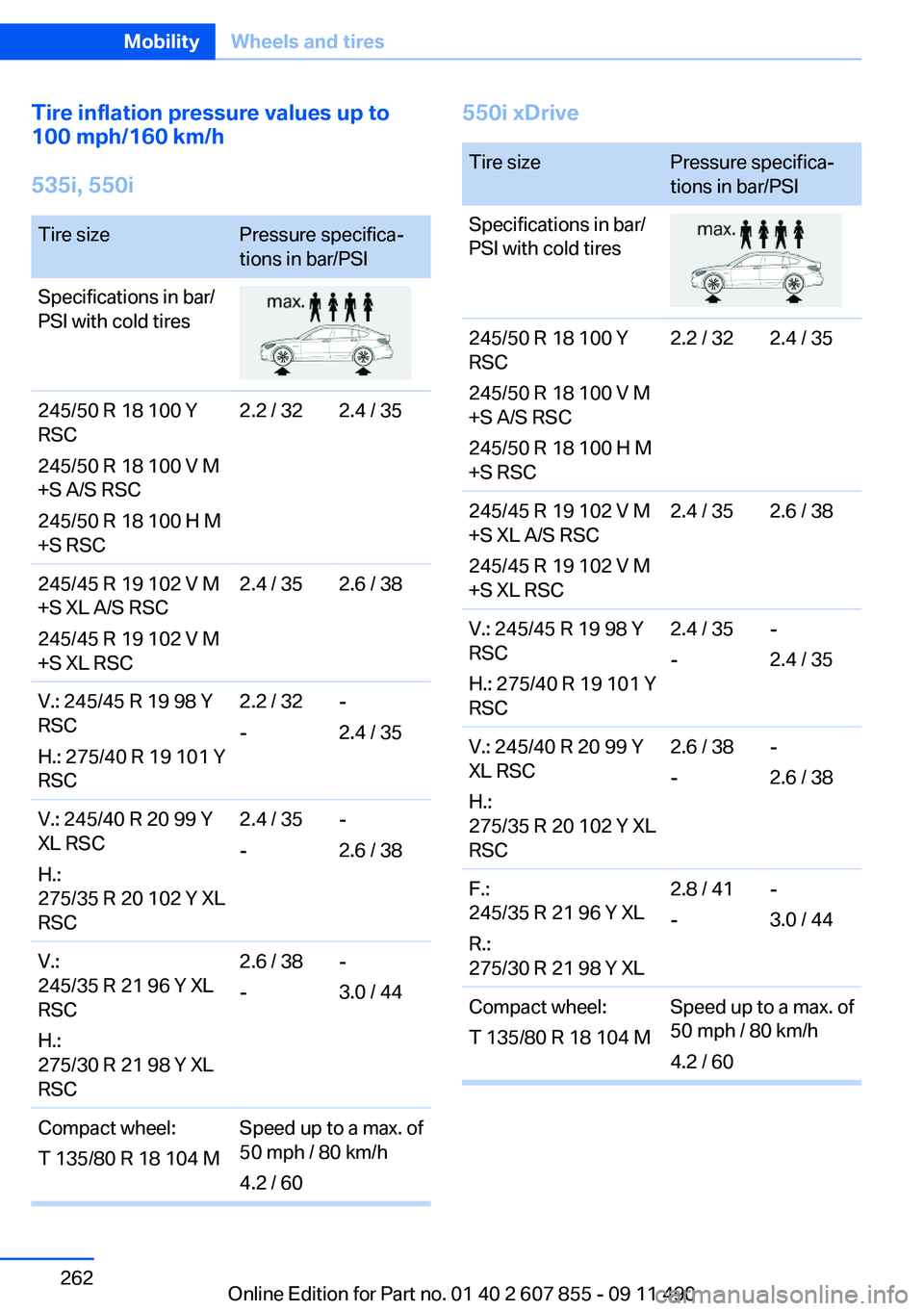
Tire inflation pressure values up to
100 mph/160 km/h
535i, 550iTire sizePressure specifica‐
tions in bar/PSISpecifications in bar/
PSI with cold tires245/50 R 18 100 Y
RSC
245/50 R 18 100 V M
+S A/S RSC
245/50 R 18 100 H M
+S RSC2.2 / 322.4 / 35245/45 R 19 102 V M
+S XL A/S RSC
245/45 R 19 102 V M
+S XL RSC2.4 / 352.6 / 38V.: 245/45 R 19 98 Y
RSC
H.: 275/40 R 19 101 Y
RSC2.2 / 32
--
2.4 / 35V.: 245/40 R 20 99 Y
XL RSC
H.:
275/35 R 20 102 Y XL
RSC2.4 / 35
--
2.6 / 38V.:
245/35 R 21 96 Y XL
RSC
H.:
275/30 R 21 98 Y XL
RSC2.6 / 38
--
3.0 / 44Compact wheel:
T 135/80 R 18 104 MSpeed up to a max. of
50 mph / 80 km/h
4.2 / 60550i xDriveTire sizePressure specifica‐
tions in bar/PSISpecifications in bar/
PSI with cold tires245/50 R 18 100 Y
RSC
245/50 R 18 100 V M
+S A/S RSC
245/50 R 18 100 H M
+S RSC2.2 / 322.4 / 35245/45 R 19 102 V M
+S XL A/S RSC
245/45 R 19 102 V M
+S XL RSC2.4 / 352.6 / 38V.: 245/45 R 19 98 Y
RSC
H.: 275/40 R 19 101 Y
RSC2.4 / 35
--
2.4 / 35V.: 245/40 R 20 99 Y
XL RSC
H.:
275/35 R 20 102 Y XL
RSC2.6 / 38
--
2.6 / 38F.:
245/35 R 21 96 Y XL
R.:
275/30 R 21 98 Y XL2.8 / 41
--
3.0 / 44Compact wheel:
T 135/80 R 18 104 MSpeed up to a max. of
50 mph / 80 km/h
4.2 / 60Seite 262MobilityWheels and tires262
Online Edition for Part no. 01 40 2 607 855 - 09 11 490
Page 263 of 321
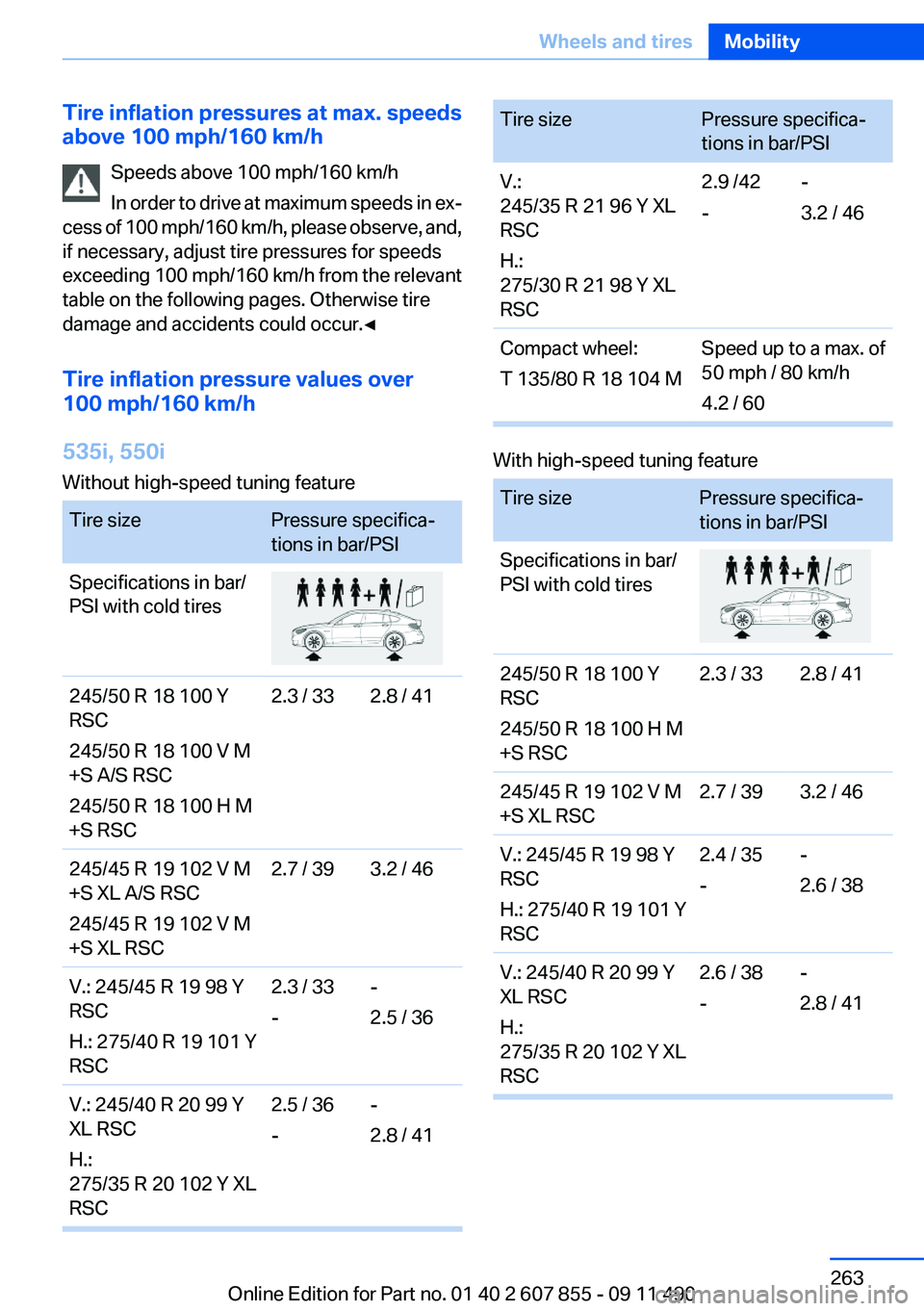
Tire inflation pressures at max. speeds
above 100 mph/160 km/h
Speeds above 100 mph/160 km/h
In order to drive at maximum speeds in ex‐
cess of 100 mph/160 km/h, please observe, and,
if necessary, adjust tire pressures for speeds
exceeding 100 mph/160 km/h from the relevant
table on the following pages. Otherwise tire
damage and accidents could occur.◀
Tire inflation pressure values over
100 mph/160 km/h
535i, 550i
Without high-speed tuning featureTire sizePressure specifica‐
tions in bar/PSISpecifications in bar/
PSI with cold tires245/50 R 18 100 Y
RSC
245/50 R 18 100 V M
+S A/S RSC
245/50 R 18 100 H M
+S RSC2.3 / 332.8 / 41245/45 R 19 102 V M
+S XL A/S RSC
245/45 R 19 102 V M
+S XL RSC2.7 / 393.2 / 46V.: 245/45 R 19 98 Y
RSC
H.: 275/40 R 19 101 Y
RSC2.3 / 33
--
2.5 / 36V.: 245/40 R 20 99 Y
XL RSC
H.:
275/35 R 20 102 Y XL
RSC2.5 / 36
--
2.8 / 41Tire sizePressure specifica‐
tions in bar/PSIV.:
245/35 R 21 96 Y XL
RSC
H.:
275/30 R 21 98 Y XL
RSC2.9 /42
--
3.2 / 46Compact wheel:
T 135/80 R 18 104 MSpeed up to a max. of
50 mph / 80 km/h
4.2 / 60
With high-speed tuning feature
Tire sizePressure specifica‐
tions in bar/PSISpecifications in bar/
PSI with cold tires245/50 R 18 100 Y
RSC
245/50 R 18 100 H M
+S RSC2.3 / 332.8 / 41245/45 R 19 102 V M
+S XL RSC2.7 / 393.2 / 46V.: 245/45 R 19 98 Y
RSC
H.: 275/40 R 19 101 Y
RSC2.4 / 35
--
2.6 / 38V.: 245/40 R 20 99 Y
XL RSC
H.:
275/35 R 20 102 Y XL
RSC2.6 / 38
--
2.8 / 41Seite 263Wheels and tiresMobility263
Online Edition for Part no. 01 40 2 607 855 - 09 11 490
Page 264 of 321
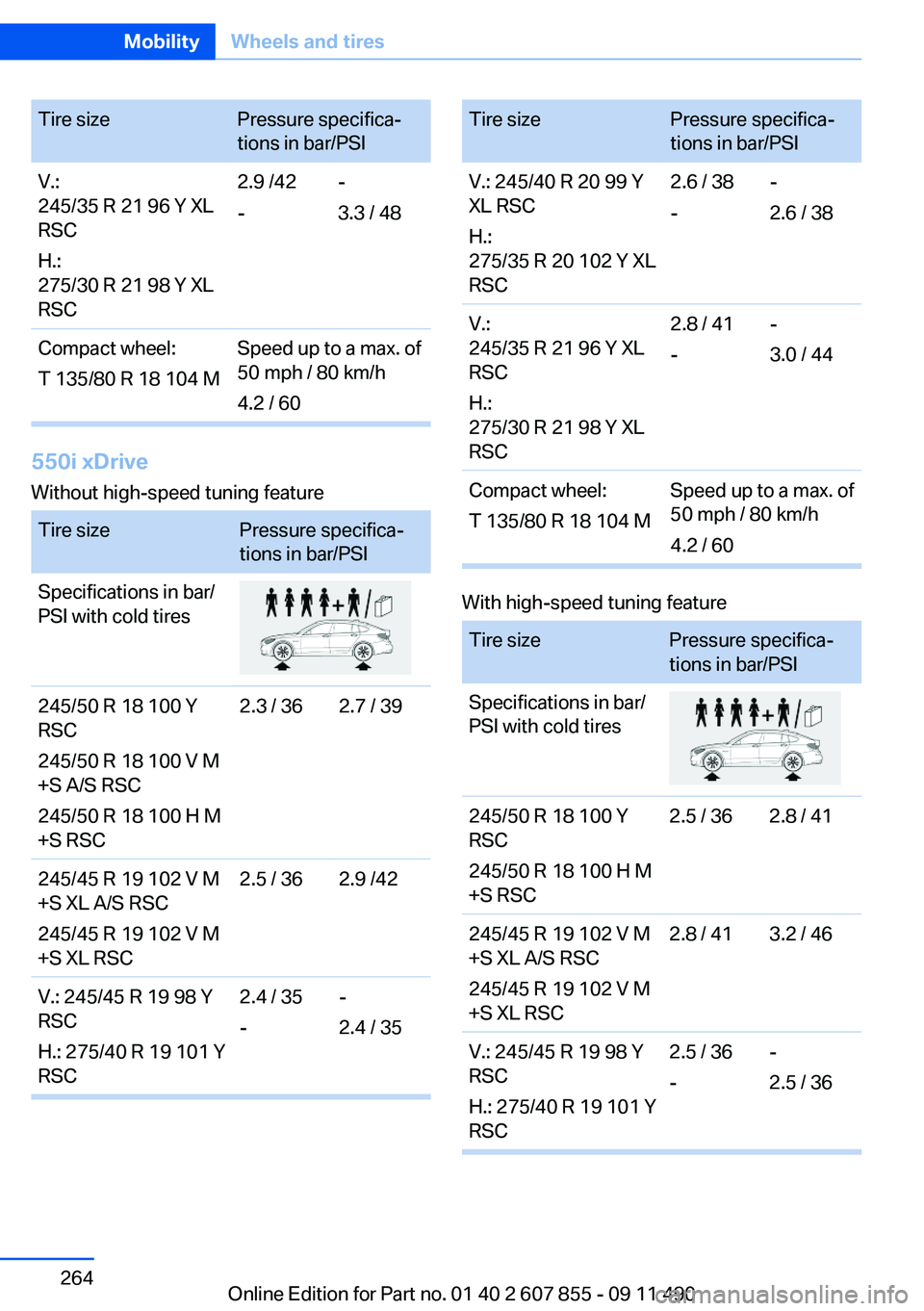
Tire sizePressure specifica‐
tions in bar/PSIV.:
245/35 R 21 96 Y XL
RSC
H.:
275/30 R 21 98 Y XL
RSC2.9 /42
--
3.3 / 48Compact wheel:
T 135/80 R 18 104 MSpeed up to a max. of
50 mph / 80 km/h
4.2 / 60
550i xDrive
Without high-speed tuning feature
Tire sizePressure specifica‐
tions in bar/PSISpecifications in bar/
PSI with cold tires245/50 R 18 100 Y
RSC
245/50 R 18 100 V M
+S A/S RSC
245/50 R 18 100 H M
+S RSC2.3 / 362.7 / 39245/45 R 19 102 V M
+S XL A/S RSC
245/45 R 19 102 V M
+S XL RSC2.5 / 362.9 /42V.: 245/45 R 19 98 Y
RSC
H.: 275/40 R 19 101 Y
RSC2.4 / 35
--
2.4 / 35Tire sizePressure specifica‐
tions in bar/PSIV.: 245/40 R 20 99 Y
XL RSC
H.:
275/35 R 20 102 Y XL
RSC2.6 / 38
--
2.6 / 38V.:
245/35 R 21 96 Y XL
RSC
H.:
275/30 R 21 98 Y XL
RSC2.8 / 41
--
3.0 / 44Compact wheel:
T 135/80 R 18 104 MSpeed up to a max. of
50 mph / 80 km/h
4.2 / 60
With high-speed tuning feature
Tire sizePressure specifica‐
tions in bar/PSISpecifications in bar/
PSI with cold tires245/50 R 18 100 Y
RSC
245/50 R 18 100 H M
+S RSC2.5 / 362.8 / 41245/45 R 19 102 V M
+S XL A/S RSC
245/45 R 19 102 V M
+S XL RSC2.8 / 413.2 / 46V.: 245/45 R 19 98 Y
RSC
H.: 275/40 R 19 101 Y
RSC2.5 / 36
--
2.5 / 36Seite 264MobilityWheels and tires264
Online Edition for Part no. 01 40 2 607 855 - 09 11 490
Page 265 of 321
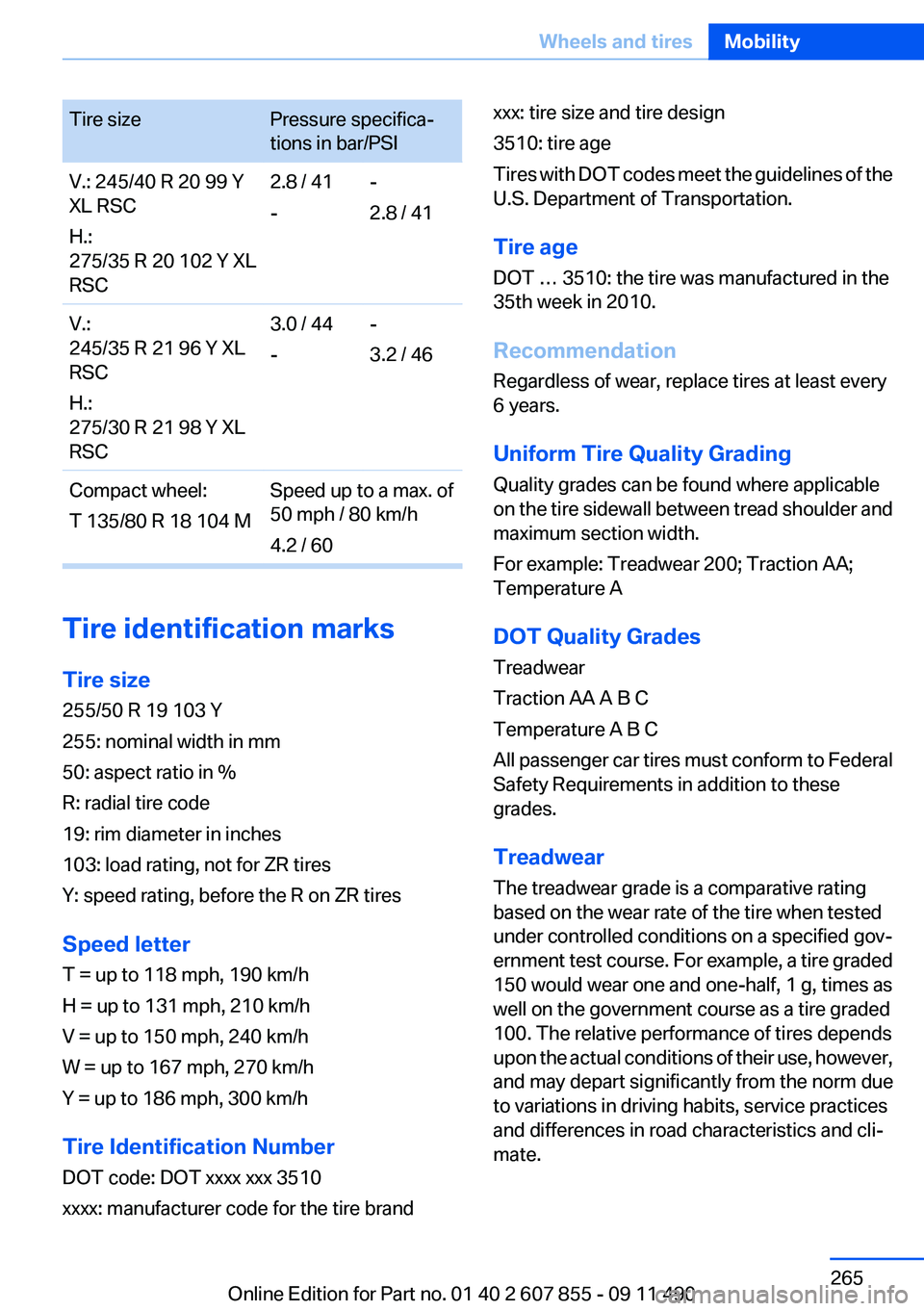
Tire sizePressure specifica‐
tions in bar/PSIV.: 245/40 R 20 99 Y
XL RSC
H.:
275/35 R 20 102 Y XL
RSC2.8 / 41
--
2.8 / 41V.:
245/35 R 21 96 Y XL
RSC
H.:
275/30 R 21 98 Y XL
RSC3.0 / 44
--
3.2 / 46Compact wheel:
T 135/80 R 18 104 MSpeed up to a max. of
50 mph / 80 km/h
4.2 / 60
Tire identification marks
Tire size
255/50 R 19 103 Y
255: nominal width in mm
50: aspect ratio in %
R: radial tire code
19: rim diameter in inches
103: load rating, not for ZR tires
Y: speed rating, before the R on ZR tires
Speed letter
T = up to 118 mph, 190 km/h
H = up to 131 mph, 210 km/h
V = up to 150 mph, 240 km/h
W = up to 167 mph, 270 km/h
Y = up to 186 mph, 300 km/h
Tire Identification Number
DOT code: DOT xxxx xxx 3510
xxxx: manufacturer code for the tire brand
xxx: tire size and tire design
3510: tire age
Tires with DOT codes meet the guidelines of the
U.S. Department of Transportation.
Tire age
DOT … 3510: the tire was manufactured in the
35th week in 2010.
Recommendation
Regardless of wear, replace tires at least every
6 years.
Uniform Tire Quality Grading
Quality grades can be found where applicable
on the tire sidewall between tread shoulder and
maximum section width.
For example: Treadwear 200; Traction AA;
Temperature A
DOT Quality Grades
Treadwear
Traction AA A B C
Temperature A B C
All passenger car tires must conform to Federal
Safety Requirements in addition to these
grades.
Treadwear
The treadwear grade is a comparative rating
based on the wear rate of the tire when tested
under controlled conditions on a specified gov‐
ernment test course. For example, a tire graded
150 would wear one and one-half, 1 g, times as
well on the government course as a tire graded
100. The relative performance of tires depends
upon the actual conditions of their use, however,
and may depart significantly from the norm due
to variations in driving habits, service practices
and differences in road characteristics and cli‐
mate.Seite 265Wheels and tiresMobility265
Online Edition for Part no. 01 40 2 607 855 - 09 11 490
Page 269 of 321
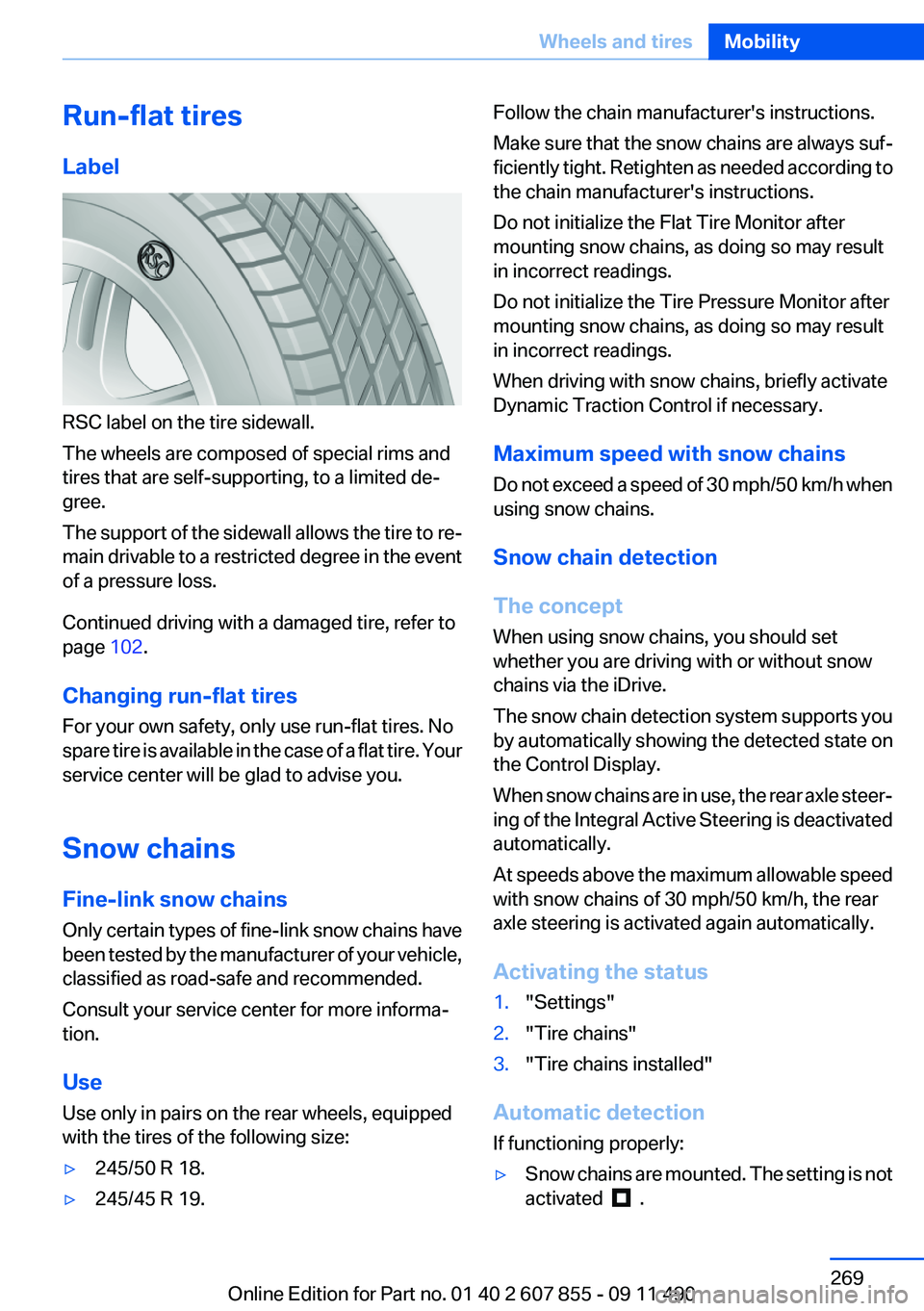
Run-flat tires
Label
RSC label on the tire sidewall.
The wheels are composed of special rims and
tires that are self-supporting, to a limited de‐
gree.
The support of the sidewall allows the tire to re‐
main drivable to a restricted degree in the event
of a pressure loss.
Continued driving with a damaged tire, refer to
page 102.
Changing run-flat tires
For your own safety, only use run-flat tires. No
spare tire is available in the case of a flat tire. Your
service center will be glad to advise you.
Snow chains
Fine-link snow chains
Only certain types of fine-link snow chains have
been tested by the manufacturer of your vehicle,
classified as road-safe and recommended.
Consult your service center for more informa‐
tion.
Use
Use only in pairs on the rear wheels, equipped
with the tires of the following size:
▷245/50 R 18.▷245/45 R 19.Follow the chain manufacturer's instructions.
Make sure that the snow chains are always suf‐
ficiently tight. Retighten as needed according to
the chain manufacturer's instructions.
Do not initialize the Flat Tire Monitor after
mounting snow chains, as doing so may result
in incorrect readings.
Do not initialize the Tire Pressure Monitor after
mounting snow chains, as doing so may result
in incorrect readings.
When driving with snow chains, briefly activate
Dynamic Traction Control if necessary.
Maximum speed with snow chains
Do not exceed a speed of 30 mph/50 km/h when
using snow chains.
Snow chain detection
The concept
When using snow chains, you should set
whether you are driving with or without snow
chains via the iDrive.
The snow chain detection system supports you
by automatically showing the detected state on
the Control Display.
When snow chains are in use, the rear axle steer‐
ing of the Integral Active Steering is deactivated
automatically.
At speeds above the maximum allowable speed
with snow chains of 30 mph/50 km/h, the rear
axle steering is activated again automatically.
Activating the status1."Settings"2."Tire chains"3."Tire chains installed"
Automatic detection
If functioning properly:
▷Snow chains are mounted. The setting is not
activated
.
Seite 269Wheels and tiresMobility269
Online Edition for Part no. 01 40 2 607 855 - 09 11 490
Page 282 of 321
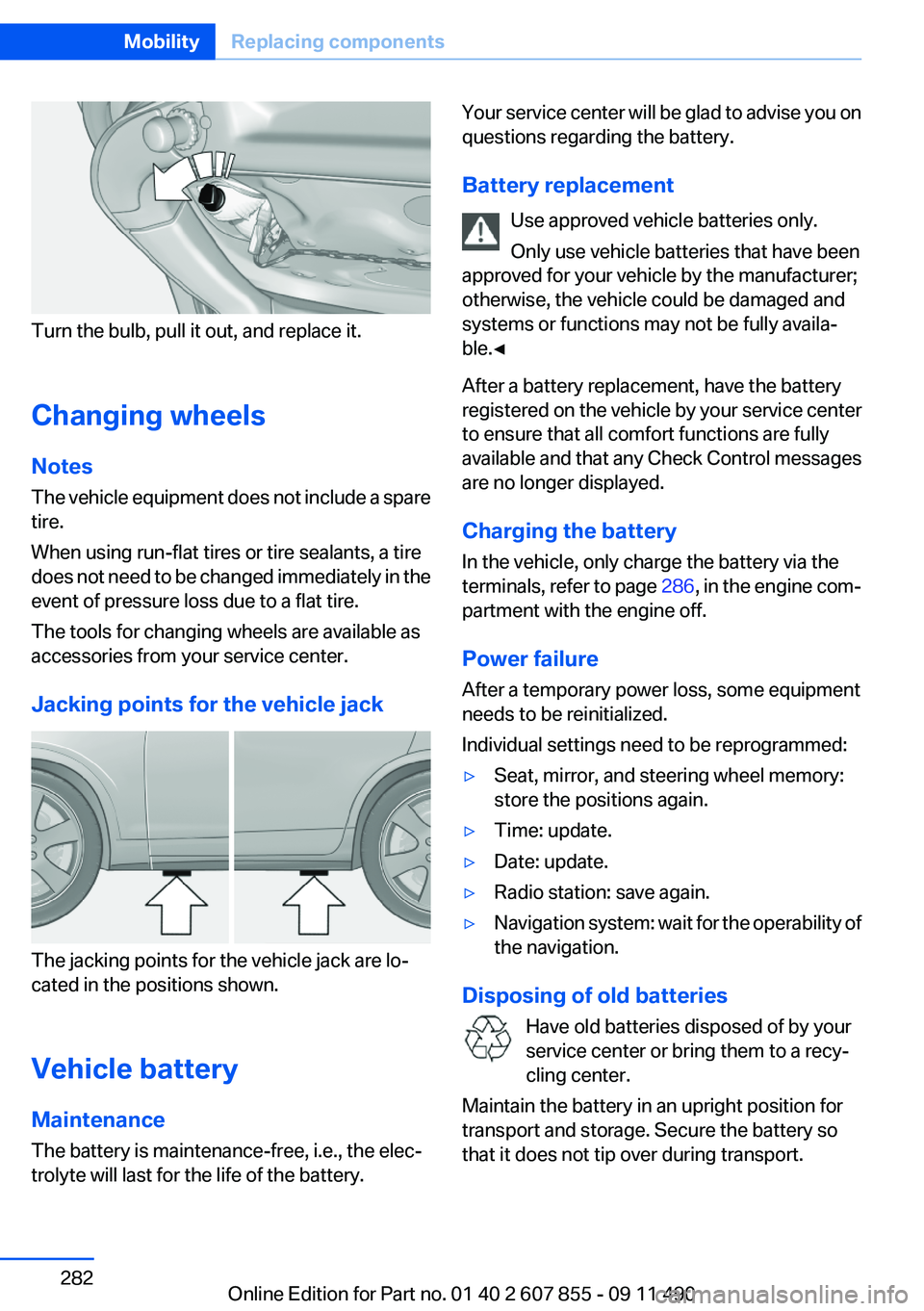
Turn the bulb, pull it out, and replace it.
Changing wheels
Notes
The vehicle equipment does not include a spare
tire.
When using run-flat tires or tire sealants, a tire
does not need to be changed immediately in the
event of pressure loss due to a flat tire.
The tools for changing wheels are available as
accessories from your service center.
Jacking points for the vehicle jack
The jacking points for the vehicle jack are lo‐
cated in the positions shown.
Vehicle battery
Maintenance
The battery is maintenance-free, i.e., the elec‐
trolyte will last for the life of the battery.
Your service center will be glad to advise you on
questions regarding the battery.
Battery replacement Use approved vehicle batteries only.
Only use vehicle batteries that have been
approved for your vehicle by the manufacturer;
otherwise, the vehicle could be damaged and
systems or functions may not be fully availa‐
ble.◀
After a battery replacement, have the battery
registered on the vehicle by your service center
to ensure that all comfort functions are fully
available and that any Check Control messages
are no longer displayed.
Charging the battery
In the vehicle, only charge the battery via the
terminals, refer to page 286, in the engine com‐
partment with the engine off.
Power failure
After a temporary power loss, some equipment
needs to be reinitialized.
Individual settings need to be reprogrammed:▷Seat, mirror, and steering wheel memory:
store the positions again.▷Time: update.▷Date: update.▷Radio station: save again.▷Navigation system: wait for the operability of
the navigation.
Disposing of old batteries
Have old batteries disposed of by your
service center or bring them to a recy‐
cling center.
Maintain the battery in an upright position for
transport and storage. Secure the battery so
that it does not tip over during transport.
Seite 282MobilityReplacing components282
Online Edition for Part no. 01 40 2 607 855 - 09 11 490